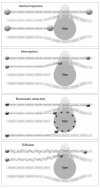Engineered nanomaterials: exposures, hazards, and risk prevention
- PMID: 21418643
- PMCID: PMC3071337
- DOI: 10.1186/1745-6673-6-7
Engineered nanomaterials: exposures, hazards, and risk prevention
Abstract
Nanotechnology presents the possibility of revolutionizing many aspects of our lives. People in many settings (academic, small and large industrial, and the general public in industrialized nations) are either developing or using engineered nanomaterials (ENMs) or ENM-containing products. However, our understanding of the occupational, health and safety aspects of ENMs is still in its formative stage. A survey of the literature indicates the available information is incomplete, many of the early findings have not been independently verified, and some may have been over-interpreted. This review describes ENMs briefly, their application, the ENM workforce, the major routes of human exposure, some examples of uptake and adverse effects, what little has been reported on occupational exposure assessment, and approaches to minimize exposure and health hazards. These latter approaches include engineering controls such as fume hoods and personal protective equipment. Results showing the effectiveness - or lack thereof - of some of these controls are also included. This review is presented in the context of the Risk Assessment/Risk Management framework, as a paradigm to systematically work through issues regarding human health hazards of ENMs. Examples are discussed of current knowledge of nanoscale materials for each component of the Risk Assessment/Risk Management framework. Given the notable lack of information, current recommendations to minimize exposure and hazards are largely based on common sense, knowledge by analogy to ultrafine material toxicity, and general health and safety recommendations. This review may serve as an overview for health and safety personnel, management, and ENM workers to establish and maintain a safe work environment. Small start-up companies and research institutions with limited personnel or expertise in nanotechnology health and safety issues may find this review particularly useful.
Figures






References
-
- Stone V, Nowack B, Baun A, van den Brink N, Kammer F, Dusinska M, Handy R, Hankin S, Hassellov M, Joner E, Fernandes TF. Nanomaterials for environmental studies: classification, reference material issues, and strategies for physico-chemical characterisation. Sci Total Environ. 2010;408:1745–1754. doi: 10.1016/j.scitotenv.2009.10.035. - DOI - PubMed
-
- Oberdörster G. Safety assessment for nanotechnology and nanomedicine: concepts of nanotoxicology. J Int Med. 2009;267:89–105. - PubMed
-
- Grieger KD, Hansen SF, Baun A. The known unknowns of nanomaterials: describing and characterizing uncertainty within environmental, health and safety risks. Nanotoxicology. 2009;3:222–233. doi: 10.1080/17435390902944069. - DOI
-
- Bergamaschi E. Occupational exposure to nanomaterials: present knowledge and future development. Nanotoxicology. 2009;3:194–201. doi: 10.1080/17435390903037038. - DOI
LinkOut - more resources
Full Text Sources

